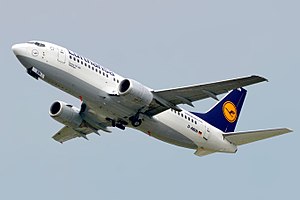B737-300
| Boeing 737 Classic 737-300/-400/-500 |
|
|---|---|
 |
|
| Lufthansa 737-300, the first 737 Classic model, during climbout after takeoff in 2011 | |
| Role | Narrow-body jet airliner and Business jet |
| National origin | United States |
| Manufacturer | Boeing Commercial Airplanes |
| First flight | February 24, 1984 |
| Introduction | November 28, 1984 with USAir |
| Status | In service |
| Primary users |
Southwest Airlines UTair Alaska Airlines |
| Produced | 1981–2000 |
| Number built | 1,988 |
| Developed from | Boeing 737 |
| Developed into | Boeing 737 Next Generation |
The Boeing 737 Classic refers to the -300/-400/-500 series of the Boeing 737. It is the second generation derivative of the 737, following the original -100/-200 models that began production in 1966. They are short- to medium-range, narrow-body jet airliners. Produced by Boeing Commercial Airplanes from 1984 to 2000, the 737 Classic includes three variants and can seat between 145 and 188 passengers. Improvements over the previous generation of 737 aircraft included CFM International CFM56 high bypass ratio turbofan engines, upgraded avionics, and increased passenger capacity (in the -300/-400 models).
The first model of the Classic series, the 737–300, entered service in 1984. It was followed by a stretched model, the 737-400, which entered service in 1988, followed by shortened 737-500, the smallest variant in the classic series, in 1990. In total, 1,988 aircraft were delivered. The Classic series was introduced as the 'new generation' of the 737, but following the introduction of the 737 Next Generation in the mid-1990s, was officially designated as the 737 Classic series.
Following the success of the Boeing 737-200 Advanced, Boeing wanted to increase capacity and range, incorporating improvements to upgrade the plane to modern specifications, while also retaining commonality with previous 737 variants. Development began in 1979, and in 1980 preliminary aircraft specifications were released at the Farnborough Airshow. The new series featured CFM56 turbofan engines, yielding significant gains in fuel economy and a reduction in noise, but also posing an engineering challenge given the low ground clearance of the 737 - a trait of its 707-derived fuselage. Boeing and engine supplier CFMI solved the problem by placing the engine ahead of (rather than below) the wing, and by moving engine accessories to the sides (rather than the bottom) of the engine pod, giving the 737 a distinctive non-circular air intake.
...
Wikipedia
